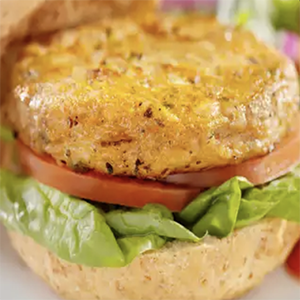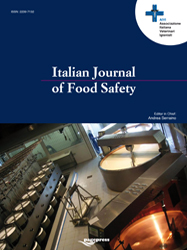Original Articles
Vol. 11 No. 3 (2022)
DNA metabarcoding for identification of species used in fish burgers

Publisher's note
All claims expressed in this article are solely those of the authors and do not necessarily represent those of their affiliated organizations, or those of the publisher, the editors and the reviewers. Any product that may be evaluated in this article or claim that may be made by its manufacturer is not guaranteed or endorsed by the publisher.
All claims expressed in this article are solely those of the authors and do not necessarily represent those of their affiliated organizations, or those of the publisher, the editors and the reviewers. Any product that may be evaluated in this article or claim that may be made by its manufacturer is not guaranteed or endorsed by the publisher.
Received: 15 February 2022
Accepted: 23 May 2022
Accepted: 23 May 2022
1365
Views
722
Downloads
29
HTML
Most read articles by the same author(s)
- Elisabetta Bonerba, Edmondo Ceci, Giancarlo Bozzo, Angela Di Pinto, Giuseppina Tantillo, Analysis of the sulphite content in shrimps and prawns , Italian Journal of Food Safety: Vol. 2 No. 2 (2013)
- Giuseppina Tantillo, Marilisa Bottaro, Angela Di Pinto, Vito Martella, Pietro Di Pinto, Valentina Terio, Virus infections of honeybees Apis Mellifera , Italian Journal of Food Safety: Vol 4, No 3 (2015)
- Elisabetta Bonerba, Edmondo Ceci, Nicola Montemurro, Giuseppina Tantillo, Angela Di Pinto, Gaetano Vitale Celano, Giancarlo Bozzo, Rapid modified QuEChERS method for pesticides detection in honey by high-performance liquid chromatography UV-visible , Italian Journal of Food Safety: Vol. 3 No. 2 (2014)
- Elisabetta Bonerba, Anna Mottola, Antonio Parisi, Angela Di Pinto, Andrea Serraino, Giancarlo Bozzo, Federica Giacometti, Edmondo Ceci, Giuseppina Tantillo, Detection of Arcobacter spp. in Mytilus galloprovincialis samples collected from Apulia region , Italian Journal of Food Safety: Vol. 4 No. 1 (2015)
- Giuseppina Tantillo, Patrizia Marchetti, Anna Mottola, Valentina Terio, Marilisa Bottaro, Elisabetta Bonerba, Giancarlo Bozzo, Angela Di Pinto, Occurrence of mislabelling in prepared fishery products in Southern Italy , Italian Journal of Food Safety: Vol 4, No 3 (2015)
- Roberta Barrasso, Elisabetta Bonerba, Edmondo Ceci, Rocco Roma, Antonio Alò, Anna Mottola, Patrizia Marchetti, Gaetano Vitale Celano, Giancarlo Bozzo, Evaluation of the animal welfare during religious slaughtering , Italian Journal of Food Safety: Vol. 9 No. 1 (2020)
- Nicoletta Cristiana Quaglia, Flavia Capuozzo, Edmondo Ceci, Stefania Cometa, Angela Di Pinto, Anna Mottola, Roberta Piredda, Angela Dambrosio, Preliminary survey on the occurrence of microplastics in bivalve mollusks marketed in Apulian fish markets , Italian Journal of Food Safety: Vol. 12 No. 2 (2023)
- Chiara Disanto, Giuseppe Celano, Angela Dambrosio, Nicoletta Cristiana Quaglia, Giancarlo Bozzo, Antonio Tritto, Gaetano Vitale Celano, Food safety in collective catering: knowledge, attitudes and correct application of GHP/GMP knowledge among foodservice workers , Italian Journal of Food Safety: Vol. 9 No. 4 (2020)
- Giancarlo Bozzo, Edmondo Ceci, Elisabetta Bonerba, Angela Di Pinto, Gaetano Vitale Celano, Giuseppina Tantillo, Occurrences of ochratoxin A in slaughtered wild boar (Sus scrofa) , Italian Journal of Food Safety: Vol. 2 No. 3 (2013)
- Marta Caruso, Laura Latorre, Gianfranco Santagada, Rosa Fraccalvieri, Laura Maria Difato, Angela Miccolupo, Loredana Capozzi, Elisabetta Bonerba, Anna Mottola, Antonio Parisi, Arcobacter spp. in bovine milk: An emerging pathogen with potential zoonotic risk , Italian Journal of Food Safety: Vol. 7 No. 4 (2018)






